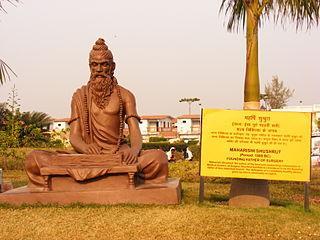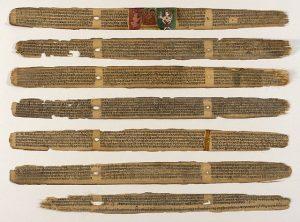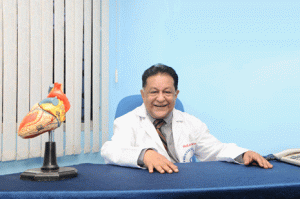By:Surinder Jain.
The Royal Australia College of Surgeons (RACS), trains surgeons and is responsible for maintaining surgical standards in Australia and New Zealand. It aims to foster and promote the pursuit of excellence in surgical education and actively supports innovative surgical research, aid projects in underprivileged communities, skills transfer and education programs.
In its building, among some of the most prominent ancient physicians, one may come across a statue of Sushrata with the plaque mentioning him as Father of Surgery.
When contacted, the RACS were very proud of having the now famous statue in their building. The statue is displayed at the Royal Australasian College of Surgeons in Melbourne and has been on display since early June 2018. It is made of marble with a granite base, is 1.2 m high and weighs a massive 550Kg. It is installed in the Skills lab area, East wing level 1 of the building and according to the RACS college, is a true work of art.
The college also has a collection of many rare and significant books in the field of medicine in its Cowlishaw Collection. A 1907 English translation of the works of Sushruta known as Sushruta Samhita by Kunjalal Bishnagratan is a part of that prestigious collection. According to the college, Sushruta is a foundation figure in Indian medicine and surgery and is hailed as the Indian counterpart of Hippocrates .
College museum which holds the translation of Sushruta Samhita is open to the public twice a week Tuesdays and Thursdays from 10am to 12noon (check with the college here for latest details). The college curator can arrange private tours for groups or if people are interested in viewing a particular item. That can be arranged by contacting the college curator at Royal Australasian College of Surgeons, 250-290 Spring Street, East Melbourne VIC 3002 Australia, Telephone: +61 3 9276 7447, Fax: +61 3 9249 1219
Email: college.curator@surgeons.org
The statue was donated to the college by one its Alumni, Dr K M Cherian. Dr Cherian performed India’s first successful Coronary Artery bypass surgery in 1975. He also performed the country’s first heart transplant after legalization of brain death. The first Heart- Lung Transplant, the first Paediatric Transplant and the first TMR (Laser Heart Surgery) were also performed by him[1].
He started his career in Christian Medical College Hospital, in Vellore as lecturer in Surgery. He did his FRACS in Cardiothoracic Surgery in 1973 from RACS, while being a migrant in Australia. He also worked in New Zealand and the United States. He worked as a Special Fellow in Paediatric Cardiac Surgery in Birmingham, Alabama under Dr. John W. Kirklin and in the University of Oregon under Dr. Albert Starr. He is an honourable Prof at the Yangzhou University, China. He was awarded Padma Shri by the Government of India in 1991.
Dr Cherian is very fond of and inspired by Sushruta.
The Indian epic Mahābhārata lists Suśruta amongst the sons of Viśvāmitra, the legendary sage.[8] [9] The Bower Manuscript, an early birch bark document, dated to the Gupta era (between the 4th and the 6th century), is an Indian text and is one of the oldest manuscripts known to have survived into the modern era.[3] It mentions the ancient Indian tradition of “garlic festival”, as well as a mention of sage Sushruta in Benares (Varanasi).[6]
The Suśruta-saṃhitā (works of Sushruta) is one of the most important surviving ancient treatises on medicine and is considered a foundational text of Medicine. The treatise addresses all aspects of general medicine, and the translator G. D. Singhal dubbed Suśruta “the father of surgery” on account of the extraordinarily accurate and detailed accounts of surgery to be found in the work.[5]

A statue dedicated to Sushruta at the Patanjali Yogpeeth institute in Haridwar. In the sign next to the statue, Patanjali Yogpeeth attributes the title of Maharishi to Sushruta, claims a floruit of 1500 BC for him, and dubs him the “founding father of surgery”, and identifies the Sushrut Samhita as “the best and outstanding commentary on Medical Science of Surgery”.
The Suśruta-saṃhitā was known to the scholar Dṛḍhabala (fl. 300–500 CE)[7] and some concepts from it can be found in the Śatapatha-Brāhmaṇa, that is dated to the sixth century BCE,[6]
The Suśruta-saṃhitā, in its 184 chapters contains descriptions of
- 1,120 illnesses,
- 700 medicinal plants,
- 64 preparations from mineral sources and
- 57 preparations based on animal sources.
The text discusses surgical techniques of
- making incisions,
- probing,
- extraction of foreign bodies,
- alkali and thermal cauterization,
- tooth extraction,
- excisions, and
- trocars for draining abscess,
- draining hydrocele and ascitic fluid,
- removal of the prostate gland,
- urethral stricture dilatation,
- vesicolithotomy,
- hernia surgery,
- caesarian section,
- management of haemorrhoids,
- fistulae,
- laparotomy and
- management of intestinal obstruction,
- perforated intestines and
- accidental perforation of the abdomen with protrusion of omentum and
- the principles of fracture management, viz., traction, manipulation, apposition and stabilization including some measures of rehabilitation and
- fitting of prosthetic.
It enumerates six types of dislocations, twelve varieties of fractures, and classification of the bones and their reaction to the injuries, and gives a classification of eye diseases including cataract surgery.

Nepal, Text- 12th-13th century; Images- 18th-19th century Books Ink and opaque watercolor on palm leaf Gift of Emeritus Professor and Mrs. Thomas O. Ballinger (M.87.271a-g) South and Southeast Asian Art
Sushruta says that in his works, he has presented the teaching of his guru, Divodāsa[16] a physician who taught in a school in Kashi (Varanasi, India) in parallel to another medical school in Taxila (on Jhelum river, ancient India),[17][18] sometime between 1200 BC and 600 BC.[19][20] The text uses terminology of Samkhya and other schools of Hindu philosophy.[32][33][34]
The text was translated to Arabic as Kitab Shah Shun al-Hindi’ in Arabic, also known as Kitab i-Susurud, in Baghdad during the early 8th century at the instructions of a member of the Barmakid family of Baghdad.[138][10] Yahya ibn Barmak facilitated a major effort at collecting and translating Sanskrit texts such as Vagbhata’s Astangahrdaya Samhita, Ravigupta’s Siddhasara and Sushruta Samhita.[139] The Arabic translation reached Europe by the end of the medieval period. In Italy, the Branca family[11] of Sicily and Gaspare Tagliacozzi (Bologna) became familiar with the techniques of Sushruta.[10]
The text was known to the Khmer king Yaśovarman I (fl. 889-900) of Cambodia. Suśruta was also known as a medical authority in Tibetan literature.[138]
A cataract surgery was found by Sushruta and was subsequently introduced to other countries. Sushruta Samhita mentions the operation in which a curved needle was used to push the opaque phlegmatic matter (kapha in Sanskrit) in the eye out of the way of vision.
“vv. 57-61ab: In moderate season, after unction and sudation, the patient should be positioned and held firmly while gazing at his nose steadily. Now the wise surgeon leaving two parts of white circle from the black one towards the outer canthus should open his eyes properly free from vascular network and then with a barley-tipped rod-like instrument held firmly in hand with middle, index and thumb fingers should puncture the natural hole-like point with effort and confidence not below, above or in sides. The left eye should be punctured with right hand and vice-versa. When punctured properly a drop of fluid comes out and alsoe there is some typical sound.”
The cataract operation method described by Sushruta continued to be used throughout the Middle Ages and is still used in some parts of Africa and in Yemen.[20] For the most part, it has now been replaced by extracapsular cataract surgery. The first references to cataract and its treatment in Europe are found in 29 AD in De Medicinae, the work of the Latin encyclopedist Aulus Cornelius Celsus, who used Sushruta’s method and called it Couching.
The Sushruta Samhita states, per Hoernle translation, that “the professors of Ayurveda speak of three hundred and sixty bones, but books on Salya-Shastra(surgical science) know of only three hundred”.[125] The text then lists the total of 300 as follows: 120 in the extremities (e.g. hands, legs), 117 in pelvic area, sides, back, abdomen and breast, and 63 in neck and upwards.[125] The text then explains how these subtotals were empirically verified.[126] The discussion shows that the Indian tradition nurtured diversity of thought, with Sushruta school reaching its own conclusions and differing from the Atreya-Caraka tradition.[126]
Anatomy and empirical studies
The different parts or members of the body as mentioned before including the skin, cannot be correctly described by one who is not well versed in anatomy. Hence, any one desirous of acquiring a thorough knowledge of anatomy should prepare a dead body and carefully, observe, by dissecting it, and examine its different parts.
—Sushruta Samhita, Book 3, Chapter V
Translators: Loukas et al[8]
The Sushruta Samhita is best known for its approach and discussions of surgery.[44] It was one of the first in human history to suggest that a student of surgery should learn about human body and its organs by dissecting a dead body.[44] A student should practice, states the text, on objects resembling the diseased or body part.[130] Incision studies, for example, are recommended on Pushpaphala(squash, Cucurbita maxima), Alavu (bottle gourd, Lagenaria vulgaris), Trapusha (cucumber, Cucumis pubescens), leather bags filled with fluids and bladders of dead animals.[130]
Reconstructive surgery techniques were being carried out in India by 800 BC.[8] Sushruta made important contributions to the field of plastic and cataract surgery.[9] The medical works of both Sushruta and Charak, are originally in Sanskrit language.
British physicians traveled to India to see rhinoplasties being performed by Indian methods.[12] Reports on Indian rhinoplasty performed by a Kumhar vaidya were published in the Gentleman’s Magazine by 1794.[12] Joseph Constantine Carpue spent 20 years in India studying local plastic surgery methods.[12] and finally in 1814, he performed the first major surgery operative procedure on a British military officer who had lost his nose to the toxic effects of mercury treatments.[13] Instruments described in the Sushruta Samhita were further modified for use in the Western world.[13]
Sushruta, states Tipton, asserts that a physician should invest effort to prevent diseases as much as curative remedial procedures.[124] An important means for prevention, states Sushruta, is physical exercise and hygienic practices.[124] The text adds that excessive strenuous exercise can be injurious and make one more susceptible to diseases, cautioning against such excess.[12] Regular moderate exercise, suggests Sushruta, improves resistance to disease and physical decay.[124] Shushruta has written Shlokas on prevention of diseases.
A number of Sushruta’s contributions have been discussed in modern literature. Some of these include Hritshoola (heart pain), circulation of vital body fluids (such as blood (rakta dhatu) and lymph (rasa dhatu), Madhumeha, obesity, and hypertension.[46] Kearns & Nash (2008) state that the first mention of leprosy is described in Sushruta Samhita.[135][136] The text discusses kidney stones and its surgical removal.[137]
With so much in his book (Sushruta Samhita), no wonder Maharishi Sushruta has been called Father of Surgery and it is no surprise that a prestigious and learned college like The Royal Australian College of Surgeons has given Sushruta such a place of honor in its temple of learning.
(Credit:Wikipedia)







